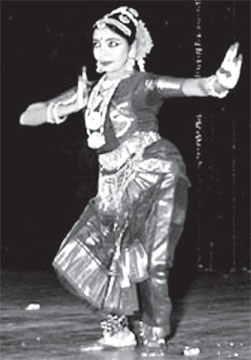The temple and Indian classical dances
by Subashini PATHMANATHAN
In most temples in south India, East India, North central India, and
West India the institution of devadasis, flourished. The devadasis were
attached to the temples, as the hand maids of the Lord. According to
puranic sources, the female dancers were proficient in music and dance.
There is also historical evidence that there was a practice of
dedicating female children to the service of the Lord. The children were
expected to sing and dance in temple rituals, processions and festivals.
The practice existed in Vaishnava and Saiva temples. During the reign of
Emperor Raja Raja Chola-1 there were altogether 400 devadasis (female
dancers) of the Thanchai Brgatheeswara temple.
 In different states in India, the temple dancers were called by
different names. In Orissa the devadasis were called Maharis.There is
evidence that the Maharis were attached to the Jagannath temple in Puri,
and some other temples, in Bhuwaneswar, Jhankad, and Kakapur. In different states in India, the temple dancers were called by
different names. In Orissa the devadasis were called Maharis.There is
evidence that the Maharis were attached to the Jagannath temple in Puri,
and some other temples, in Bhuwaneswar, Jhankad, and Kakapur.
Today Orissa state's classical dance form is known as Odissi. Odissi
dance had its links and roots with the practice of devadasi tradition of
Odissa. This practice started during the reign of king Chodagandadeva,
(1077 A.D -1147 A.D) who built the famed Jaganath temple and introduced
the dance by Maharis to serve the Lord.
In West Indian state of Maharastra the devadasis were called Murlis.
Similarly in the East Indian state of Assam, the devadasis were called
Nathis.
Yakshagana
In south Assam a dance called Yakshagana had its close ties with
dramas. That is why Yakshagana was regarded as a dance drama.
Like many other classical Indian dance forms, this particular dance
was also practised and performed in temples, and temple festivals.
Sattariya is another dance form of East Indian state of Assam. It
originated in the 16th century. This was practised in the Vaishnava
monasteries. Chhu, another dance form of Assam is performed during the
temple festival. This danced is for the worship of Lord
Arthanaareeswarar.
The Telegu Desha classical dance form is Kuchupidi. Like most of the
Indian classical dance forms, Kuchupidi, has its links with Hindu
religious customs and traditions.
Kuchupidi has its origin in the village of Kuchupidi, in the modern
Andhra State. Earlier it was performed in the Ramalingeswara Temple, and
later it was performed in various other temples.
In Kerala, chakiyar koothu, koodiattam, Krishna attam, and Kathakali,
are the main dance forms of Kerala. The dances have their close links
with temple tradition and temple customs.
Chakiyar were the male dancers. (There is a reference in
Sillapathikaram about chakai koothu. Koothu means dance).This dance was
performed by the chakyiar inside the temple premises.
The place where they perform chakiyar koothu inside the temple is
called koothampalam.
Kodiattam
Like chakiyar koothu there is also another temple dance based on
drama form. It is called kodiattam. This is performed by a group of male
dancers. The kodiattam is also performed in the same koothampalam where
the chakyiar koothu was held. It evolved out of various religious ritual
rites.
Similarly Krishna Attam came into existence during the 17th century.
The dance form was performed during the Krishna Jayanthi festival mainly
in the temple of Guruvayoor.
Kathakali though it did not originate in temples, but eventually it
was danced in temples.
In East Indian state Manipur, the Manipuri dance gained the worldwide
recognition. In Manipuri dance the Rasa Leela, dances are deeply linked
to devotional worship, and these dances were danced in temples. The
dances were performed at the Nat Mandapas in temples.
Bharatha Natyam evolved out of temple dance Sathir which was
essentially a temple dance. And Sathir was practised in temple rituals,
processions, and festivals. Sathir was practised and preserved by the
Devadasi clan.
The devadasis were also called Pathiyeyallar, because they were
serving in Pathi (Temples).Those who were serving in Sivan temples were
called Rishapath Taliyeyallalar.
In the 19th century, and early 20th century in Northen part of Sri
Lanka temples were having dancers called Sathirkaries, who performed in
the temples, during the temple festivals.
The customs continued till the mid of 1970s. The dancers belonged to
a particular clan or caste in the Hindu society.
And those who were serving in Vaishnava temples were called Sri
Vaishnva Manikam and the male dancers were called Ariyer. In temples
dance halls were separately established and managed.
In the Thiruvaduthuri temple, a dance hall was established and it was
called Nanavitha Nadana Saali. In the 15th century at Kachi Eekampara
Nathar temple, a dance hall was established and it was called, Nirirutha
Mandapam. Similarly Raja Raja Chola, who built the Thanjai
Bragatheeswarar temple set up a separate dance hall for dances, called
Nanavitha Nadana Saali.
Beside these, carved sculptures of temple pillars, gupura (tower)
sculptures, temple paintings (including wall and roof paintings), stone
inscriptions, and copper plate inscriptions provide a wealth of
information about the dance and the development of dance, in and around
the temples.
Hence Indian classical dance forms originated and were preserved, in
and around the temples and temple environs. The Indian classical dance
forms had their birth in temples.
|


